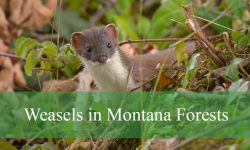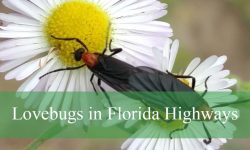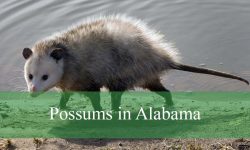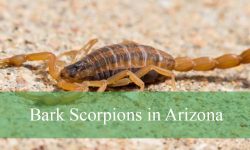Velvet ants, also known as cow killers in Georgia, are some of the most eye-catching and misunderstood insects in the southeastern United States. They are instantly recognizable because of their fiery red coloration and fuzzy bodies. Many residents come across them in backyards, pine forests, or sandy trails, often without realizing what makes these insects so unique.
Although their appearance seems intimidating at first glance, velvet ants live surprisingly solitary and secretive lives. Most people only see the adults running across open ground. Everything else about their world happens out of sight. Their life cycle, behaviors, and defenses reveal an insect far more complex than the myths that surround it.
As you explore these hidden facts, you will also understand why velvet ants thrive in Georgia, how their unusual biology works, and why they have earned such a dramatic nickname. The more closely you look, the more astonishing this species becomes.
The Hidden World of Velvet Ants in Georgia
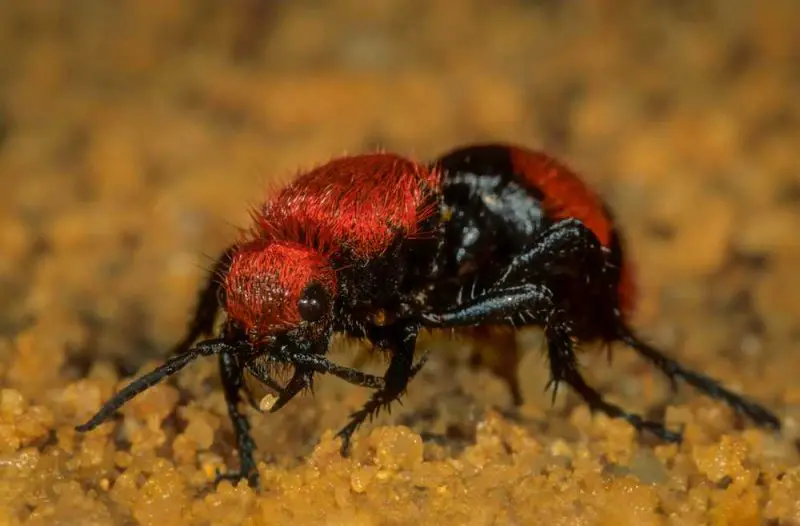
What Exactly Are Velvet Ants?
Velvet ants are not ants at all. They are wingless female wasps belonging to the family Mutillidae. This family includes hundreds of species, many of which display bright red, orange, or yellow hairs that serve as a warning signal to predators. Their appearance feels almost ornamental, but everything about their coloration is functional.
The dense velvet-like hairs help regulate temperature as the insects move across sunlit ground. The coloration also advertises their ability to defend themselves, which is important for a creature that spends much of its time exposed and running in the open.
Not Ants, but Wasps
The biggest difference between true ants and velvet ants is that female velvet ants have a powerful stinger. It is among the most robust stingers for their size in the insect world. True ants either lack stingers entirely or possess stingers specialized for colony defense.
Male velvet ants do have wings, but they cannot sting. They rely on flight to locate females and navigate wide habitats. Females, in contrast, must run everywhere they go. This creates a strong difference in their behavior and lifestyle.
Why They Live in Georgia’s Climate
Velvet ants thrive in warm, dry environments. Georgia’s long summers provide the heat they need to remain active and energetic. Sandy soil found throughout the coastal plain and inland pine regions allows them to search for underground nests belonging to bees and wasps.
These factors create ideal conditions. As a result, Georgia supports a high diversity of velvet ant species, including the well-known species Dasymutilla occidentalis, the large reddish “cow killer” that most residents encounter.
Physical Adaptations That Make Velvet Ants Unusually Tough
The Hardest Exoskeleton Among Georgia’s Insects
One of the most remarkable traits of velvet ants is their incredibly strong exoskeleton. Multiple studies have shown that their shell is far more durable than that of many bees or wasps. This is a crucial adaptation because females cannot fly. They must rely on armor and speed to survive encounters with predators.
The exoskeleton protects them from being crushed. It also enables them to move quickly through rough terrain or resist attacks from birds, reptiles, and small mammals that may attempt to eat them.
The Role of Color and Texture
The bright hairs covering the body serve several functions. They help regulate body temperature and shield the insect from ultraviolet radiation. The thick texture makes it difficult for predators to grip them tightly. It also provides a layer of insulation that can help the insect withstand sudden changes in ground temperature.
Many predators quickly learn to avoid the red and black coloration. This pattern is one of the clearest warning signs in nature, signaling that the creature is capable of delivering intense pain.
A Sting That Built a Fierce Reputation
The sting of a female velvet ant is well known for its intensity. This is the reason early farmers referred to them as cow killers. The sting delivers a sharp burning sensation that often lasts longer than the sting of most common wasps.
Although painful, the sting is not dangerous to humans or livestock. The venom is designed to deter predators and protect the insect, not to kill. Most people who are stung have accidentally stepped on or handled a velvet ant without realizing it.
Why the Sting Hurts So Much
The pain of the sting is a result of both the strength of the stinger and the potency of the venom. The stinger can penetrate deeply, and the venom activates specialized pain receptors. While the sensation is strong, the reaction typically fades within a short period unless the person has an allergy to insect stings.
Behavior and Life Cycle
Solitary Wanderers
Velvet ants live alone. They do not form colonies or social groups. Female adults spend their lives on the ground, searching for the nests of other insects. Each individual follows its own path and does not rely on cooperation with others.
This solitary lifestyle shapes every aspect of their behavior. They must defend themselves without help and navigate landscapes on their own. Their excellent sense of smell and vibration detection helps them locate underground nest entrances.
Daytime Activity
Velvet ants are active during the day. In Georgia, they are most frequently seen during hot summer afternoons when temperatures reach high levels. Their running motion is distinctive. They move in quick bursts, pause, change direction, and continue. This unusual pattern helps them scan the environment and respond quickly to threats.
Parasitoid, Not Predator
The reproductive system of velvet ants relies on parasitoid behavior. Instead of hunting prey directly, females lay their eggs inside the nests of other insects such as ground-nesting bees, bumble bees, cicada killers, or large solitary wasps.
Once the larva hatches, it consumes the host larva’s food supply. When that is depleted, the velvet ant larva then consumes the host itself. After feeding, it develops into a pupa inside the nest and later emerges as an adult wasp.
This method ensures that the larva has a safe environment rich in nutrients.
Why Velvet Ants Thrive in Georgia
The Right Habitat Conditions
Georgia’s mix of pine forests, meadows, agricultural fields, and sandy coastal landscapes creates perfect conditions for velvet ants. They prefer open or semi-open spaces where sunlight reaches the ground. The warmth increases their activity levels and helps them maintain energy.
Dry soil allows them to locate and enter underground nests more easily. Regions with loose sand, such as the fall line or coastal plains, provide especially high populations.
Diversity of Host Species
Georgia hosts a wide range of ground-nesting bees and wasps. This diversity supports healthy velvet ant populations. As long as these pollinators are present, velvet ants have the resources they need to complete their life cycle.
Wildflowers are abundant during much of the year. These flowers attract bees and wasps, indirectly sustaining the velvet ants that depend on them.
Sound, Defense, and Escape Behaviors
Audible Squeaking as a Warning
Velvet ants produce a distinctive squeaking sound when threatened. This noise is created by rubbing internal body structures together, a process called stridulation. The sound is surprisingly loud for such a small insect and is often enough to discourage predators.
Meaning of the Warning Sound
The squeak serves as an alert. When predators hear it, they quickly learn that the insect is capable of causing severe pain. This memory helps velvet ants avoid repeated attacks from the same predator species.
Chemical Defenses
Velvet ants release chemicals that signal danger. These defensive scents create a sensory barrier. Predators often back away once they detect the chemicals in the air.
Their Impressive Running Speed
Because female velvet ants cannot fly, they rely on speed to escape threats. Their rapid running allows them to cover long distances efficiently. They can dart between rocks, slip under leaves, or disappear into grass before predators can react.
Human Interaction and Safety
Why the Name “Cow Killer” Exists
The name comes from the intensity of the sting, not from any actual threat to livestock. Early settlers likely encountered the insects while farming or walking barefoot. After receiving a painful sting, they believed the insect must be capable of killing a large animal.
This was a misunderstanding, but the name continued to spread.
How Painful Is the Sting?
The sting ranks high on pain scales. Most people describe it as an immediate sharp burn that slowly fades. It rarely causes significant swelling unless the person is allergic to insect venom.
Are Velvet Ants Aggressive?
Velvet ants are not aggressive. They will never chase or pursue people. Most stings result from accidental contact. If left alone, they continue on their way without interacting with humans or pets.
Environmental Role in Georgia
Balancing Bee and Wasp Populations
Velvet ants influence the populations of ground-nesting bees and wasps. They do not wipe out these populations. Instead, they affect a small percentage of nests. This interaction contributes to natural ecological balance.
Serving as Prey
Although well protected, velvet ants are sometimes eaten by predators that have adapted to their defenses. Certain bird species, amphibians, and reptiles consume them. When this happens, the predator receives a nutrient-rich meal.
Indicators of Healthy Ecosystems
A thriving velvet ant population often signals that pollinators are present and that the soil is suitable for their nests. This makes velvet ants an indirect sign of habitat health.
Identifying Velvet Ants in Georgia
Key Features
Velvet ants are usually between half an inch and one inch long. They have bright red or orange hairs on a dark body. Their coloration is one of their most recognizable features.
Several species occur in Georgia. The largest and most common is Dasymutilla occidentalis. Other species include Dasymutilla klawei and Mutilla quinquemaculata.
Male vs. Female
Females have no wings. They also possess the stinger.
Males have wings and cannot sting.
Where You Might See Them
Velvet ants often appear on sandy trails, sidewalks, open fields, and near the nests of their host species. They are solitary, so encounters usually involve only one insect at a time.
Avoiding Stings and Respecting Their Habitat
Wear Shoes Outdoors
Many stings happen when people walk barefoot. Wearing shoes prevents accidental contact.
Avoid Picking Them Up
Most stings occur when people attempt to touch or catch them. Leaving them undisturbed ensures safety.
Keep Their Habitat Intact
Velvet ants help maintain healthy ecosystems. They should be observed rather than removed or harmed. As long as their presence is not excessive, they pose no threat.
FAQs About Velvet Ants (“Cow Killers”) in Georgia
What are velvet ants and why are they called cow killers?
Velvet ants are wingless female wasps. They are called cow killers because their sting is extremely painful, not because they can kill livestock.
Are velvet ants dangerous?
Their sting is painful but not medically dangerous for most people.
Do velvet ants sting or bite?
They do not bite. Females can sting. Males cannot sting.
What do velvet ants eat?
Adults feed on nectar. Larvae feed on the stored food and larval bodies of their host insects.
Where are velvet ants found in Georgia?
They live in pine forests, open fields, sandy trails, and gardens.
Can velvet ants fly?
Males can fly. Females cannot.
Why are velvet ants brightly colored?
Their coloration warns predators to stay away.
What should I do if I see one?
Watch from a distance and avoid touching it.
Are they harmful to pets?
Pets may experience pain from a sting, but the venom is not life-threatening unless the pet has an allergy.
Do velvet ants benefit the environment?
Yes. They help maintain natural insect balance and indicate a healthy ecosystem.
Conclusion
Velvet ants in Georgia are impressive insects with remarkable physical adaptations and complex life cycles. Their ability to survive without wings, defend themselves with a powerful sting, and thrive in Georgia’s climate makes them one of the most unique species in the region. Although their reputation as cow killers has fueled myths, the truth is that they play a valuable role in local ecosystems and pose little threat when left alone.
Understanding their behaviors, habitats, and ecological importance allows us to appreciate them for what they truly are. The next time you see a bright red velvet ant racing across a sunny trail, you will know you are witnessing one of Georgia’s most remarkable and resilient insects.

